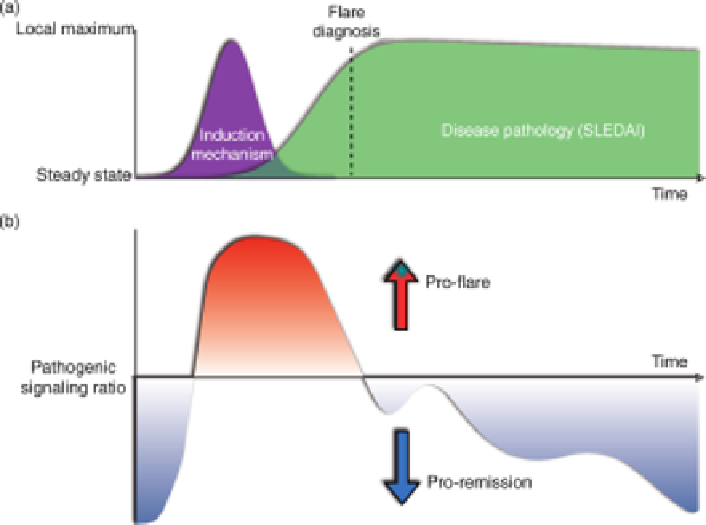Biomedical Engineering Reference
In-Depth Information
FIGURE 15.3
Prediction of SLE disease flare based on phospho flow analysis of critical
signaling pathways in patient blood samples. (a) Flare is defined as a significant increase in SLE
symptoms that corresponds to a numerically significant rise in SLEDAI score. This rise is due to a
higher level of autoimmune activity that is initiated by an inductionmechanism that may precede
the observed change in symptoms by days or even weeks. A reduction or plateau in pathology
may indicate that no further damage is occurring and that the autoimmune activity responsible for
the flare has concluded or been reduced inmagnitude. (b) The pathogenic signaling ratio (PSR) is
a numerical value comparing the ratio of two or more signaling pathways in specific cell types in
SLE patients. From our studies in SLE patient samples, PSR values below 1 correlated with
remission or static disease. PSR values significantly above 1 strongly predicted flare within 90
days, but did not correlate well with static scores of disease pathology or past symptoms. PSR
changes are temporally concordant with the induction mechanism and may be one of the earliest
detectable changes in immune system function preceding flare.
To test this hypothesis, we had to be able to calculate the rate of change of patient
symptoms through time. To have the appropriate data set, we scheduled multiple
patient visits over the course of a year, scoring symptoms at each clinical visit with
both SLEDAI and Physician's Global Assessment (PGA). Patient enrollment in three
successive cohorts was randomized to make the results broadly representative. Blood
samples were treated with a set of cytokines and multiple cell types were analyzed for
their phosphoprotein response profiles.
The resulting signaling profile consisted of hundreds of signaling nodes, which
represent the signaling response through a specific signaling molecule, in a particular

Search WWH ::

Custom Search